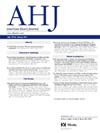局部腔槽低剂量西罗莫司洗脱生物可吸收聚合物冠状动脉支架治疗慢性全闭塞:目标CTO非效性随机试验。
IF 3.7
2区 医学
Q1 CARDIAC & CARDIOVASCULAR SYSTEMS
引用次数: 0
摘要
背景:我们的目的是比较具有腔内生物可吸收的含西罗莫司聚合物涂层的药物洗脱支架(BP-SES)与具有持久聚合物的依维莫司洗脱支架(DP-EES)在经皮冠状动脉介入治疗(PCI)慢性全闭塞(CTOs)患者中的疗效和安全性。方法:TARGET CTO是一项多中心、开放标签、非效性试验,在CTO再通成功后,将患者以1:1的比例随机分配到BP-SES或DP-EES。非劣效性评估的主要终点是支架内晚期管腔损失(LLL) 12个月。结果:共有206名受试者进行了随机分组,其中103名被分配到BP-SES组,103名被分配到DP-EES组。基线临床和血管造影特征具有可比性。主要终点BP-SES组与DP-EES组相比无劣效性(0.21±0.43 mm vs 0.21±0.33 mm;p = 0.934,双向的;差0.01mm [BP-SES - DP-EES];95% CI: -0.13 ~ 0.12 mm;结论:与DP-EES相比,BP-SES的CTOs的PCI在12个月的随访中在晚期损失和二元再狭窄方面显示相似的结果。临床试验:ClinictalTrial.gov,编号NCT03040934。本文章由计算机程序翻译,如有差异,请以英文原文为准。
Targeted therapy with a localized abluminal groove low-dose sirolimus-eluting bioabsorbable polymer coronary stent in chronic total occlusions: The TARGET CTO non-inferiority randomized trial
Background
Our objective was to compare the efficacy and safety of a drug-eluting stent featuring an abluminal bioabsorbable sirolimus-containing polymer coating (BP-SES) with an everolimus-eluting stent with a durable polymer (DP-EES) in patients undergoing percutaneous coronary intervention (PCI) for chronic total occlusions (CTOs).
Methods
TARGET CTO is a multicenter, open-label, noninferiority trial that randomized patients to either BP-SES or DP-EES in a 1:1 fashion following successful CTO re-canalization. The primary endpoint that was powered for noninferiority assessment is in-stent late lumen loss (LLL) at 12 months.
Results
A total of 206 subjects underwent randomization, with 103 assigned to the BP-SES group and 103 to the DP-EES group. Baseline clinical and angiographic characteristics were comparable. The primary endpoint demonstrated noninferiority for the BP-SES group compared to the DP-EES group (0.21 ± 0.43 mm vs 0.21 ± 0.33 mm; P = .934, 2-sided; difference 0.01mm [BP-SES minus DP-EES]; 95% CI: -0.13 to 0.12 mm; p noninferiority < .001,1-sided). No significant differences were observed in secondary angiographic or clinical endpoints. The rates of 12-month in-stent and in-segment binary restenosis in the BP-SES group and the DP-EES group were similar (6.8% vs 7.5%, P = .86; and 8.1% vs 8.8%; P = .89, respectively). Although there was a trend favoring the BP-SES group, the difference between the BP-SES group and DP-EES group at 12 months in target lesion failure (2.1% vs 8.0%, P = .054) and target lesion revascularization (2.1% vs 7.1%, P = .089) did not reach statistical significance. No definite or probable stent thromboses were reported in either group.
Conclusions
Compared to DP-EES, PCI of CTOs with BP-SES showed similar results in terms of late loss and binary restenosis at the 12-month follow-up.
Clinical Trial
ClinictalTrial.gov, number NCT03040934
求助全文
通过发布文献求助,成功后即可免费获取论文全文。
去求助
来源期刊

American heart journal
医学-心血管系统
CiteScore
8.20
自引率
2.10%
发文量
214
审稿时长
38 days
期刊介绍:
The American Heart Journal will consider for publication suitable articles on topics pertaining to the broad discipline of cardiovascular disease. Our goal is to provide the reader primary investigation, scholarly review, and opinion concerning the practice of cardiovascular medicine. We especially encourage submission of 3 types of reports that are not frequently seen in cardiovascular journals: negative clinical studies, reports on study designs, and studies involving the organization of medical care. The Journal does not accept individual case reports or original articles involving bench laboratory or animal research.
 求助内容:
求助内容: 应助结果提醒方式:
应助结果提醒方式:


